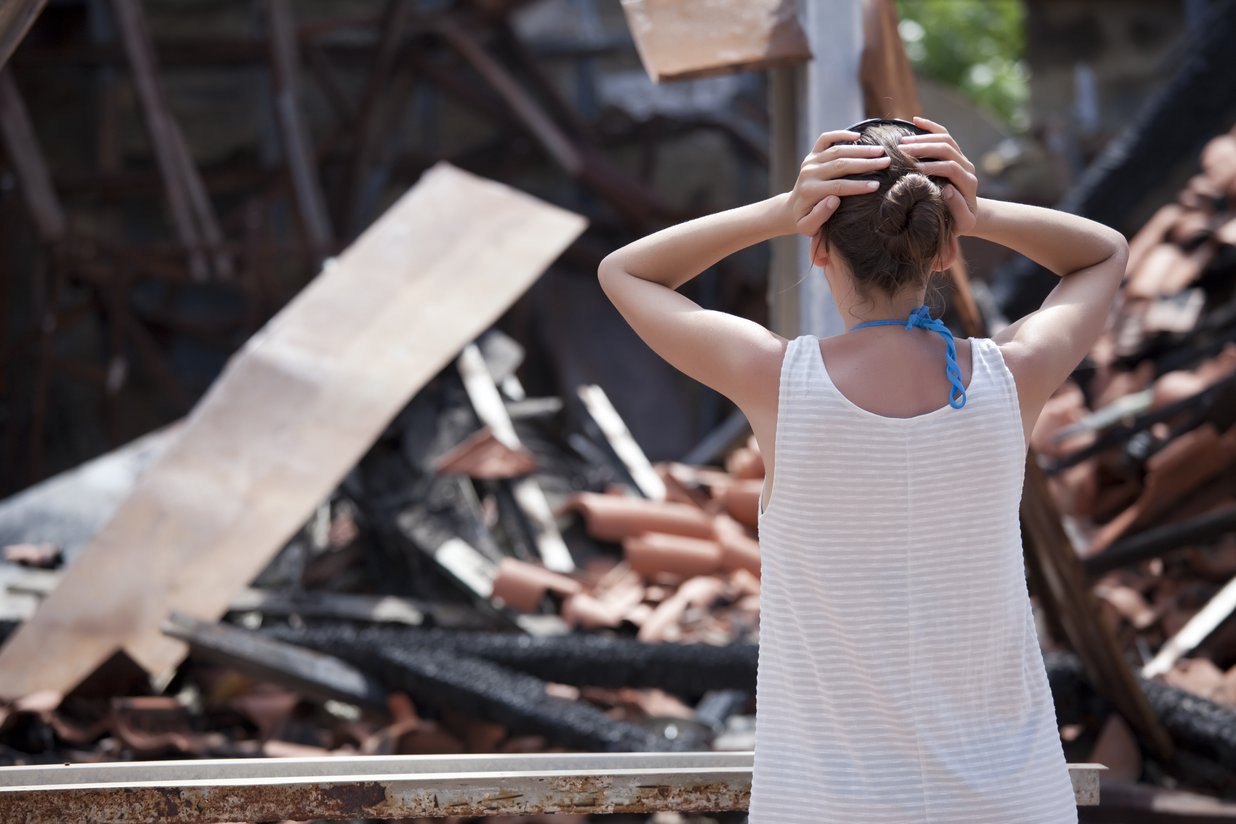Since the Tubbs Fire, we've learned a lot. As builders for our community, we believe we play a critical role in helping our community to get back to the life we once knew through rebuilding efforts. We are told that this is the new norm as ravages of wildfire continue to touch just about every corner of our beloved state. With that said, we've decided it is time to provide an updated checklist for rebuilding after disaster.

Who to Notify of Loss
Insurance Agent*:
- File claim with insurance carrier.
- Confirm what your insurance does and does not cover. Request a copy of your insurance policy from your agent which can be emailed to you.
- 4 parts of homeowner's policies:
- Building – coverage for the primary home or building and anything directly attached to it.
- Other Structures – coverage for detached buildings like a detached garage, shed, or fences. This coverage usually amounts to 10% of Building Coverage.
- Contents – if you took your house and shook it upside down, anything that falls out is considered its contents. This coverage usually amounts to 50% of your Building Coverage.
- Loss of Use – coverage usually extends 12-24 months and covers lodging along with extra expenses while you are displaced. For those who are evacuated, this coverage immediately comes into effect. Often it can take up to a year or two before disaster survivors figure out what they want to do with their property. This coverage gives you the opportunity to secure a long-term rental.
- Do not access the damaged site until you receive official notice from the proper authorities.
- When allowed, conduct a walk through the site for assessment with your insurance carrier representative. Take many pictures.
- Request a “Waiver of Itemized Contents List”. You may be able to receive a full pay out.
- You may be able to receive an “Additional Living Expenses” advance from your carrier to cover daily necessities.
- Confirm clean-up coverage. Understand what coverage obligation you have related to State & Federal clean-up programs.
- Keep ALL receipts.
- Start writing lists of everything you lost and keep updating as things come to mind.
- Compile all photographs, records and assets.
- Bank and credit card statements can be used as back-up for purchases that need to be replaced.
- Ask agent whether or not you need to continue making insurance payments if home/building is a total loss.
- Do not settle or sign any final paperwork with an insurance carrier until the entire claim is resolved and/or have an attorney review all documents.
- If required, ask your agent if your insurance will cover septic system repairs/building code upgrades due to fire.
*All insurance information provided by InterWest Insurance Services.
Mortgage Company
- If you have a mortgage, determine whether you need to advise your lender of the loss.
- Request to defer mortgage payment (lender may defer for 90 days).
- Continue paying your mortgage and property taxes during the rebuilding process.
County Assessor
- Submit an application to the County Assessor’s Office requesting an adjustment of the assessed value of your home as a result of the fire damage (Calamity Provisions of California Rev. and Tax Code).
Utilities
- Cancel or suspend the following:
- PG&E service
- Cable service
- Landline (Ask for them to waive fee)
- Garbage service
- Satellite TV service
- Internet service
- Water service
- Water main backflow inspection/test (notify city, town or county)
General Notification Items
- Get a PO Box and forward mail.
- Notify yard maintenance contractors.
- Stop water filter/softener service.
- Cancel or suspend pool service.
- Cancel or suspend pest control service.
- Update mailing address with all accounts.
- Cancel or suspend annual septic inspection/maintenance.
- Notify cleaning company.
- Cancel HVAC annual inspections.
Replace Documents (if destroyed):
- Create digital files of all documents and store on a “cloud” server.
- Driver’s license, auto registration
- Vehicle titles (pink slips)
- Bankbooks (checking, savings, etc.)
- Insurance policies
- Military discharge papers
- Passports
- Birth, death and marriage certificates
- Divorce papers
- Social Security or Medicare cards
- Credit cards
- Titles to deeds
- Stocks, bonds, mutual funds, pensions, retirement accounts and annuities.
- Wills and Trusts
- Medical records
- Warranties
- Income tax records
- Citizenship papers
- Prepaid burial contract
- Animal registration papers
- Mortgage papers
Property Clean-up:
- Do not access property until authorities assure it is safe.
- Assess the integrity of the foundations and retaining walls with a licensed structural engineer.
- Assess safety of access (clear roads, inspect bridges, etc.).
- Assess status of existing septic system & well. Identify location with prominent markers.
- Secure site by locking gates and perimeter fencing if possible.
- If using private clean-up, that will be paid by owner (maintain record of costs to submit to insurer).
- Private clean-up can expedite the process to permit submission but coordinate timeline with architect and builder so you do not waste money paying for private clean-up if the design process will take longer than waiting for County/City to clean-up.
- Clear property of hazardous material and debris.
- Use certified abatement company.
- Do not attempt to clean-up yourself.
- Up to 6"-12” of soil may need to be remove form site; this could require importing soil after hazardous cleanup is complete.
Original Design Documents:
- Confirm whether or not original house plans/specifications & related reports exist.
- Contact the original architect &/or contractor for plans and any related project information.
- Verify the rebuild project does or does not need to be current with the latest code requirements.
- Generate a rough budget on original plans:
- Issue budget to insurance company for review
- Break-out code upgrade items
- Soft cost to be figured (i.e. architect and other design consultants)
- Issue budget to insurance company for review
- Learn how much insurance will contribute
- Move forward with new design documents
- Do not assume you can re-use existing foundation. Have it inspected/tested by licensed engineer.
New Design Documents:
- Find an architect & builder to start coordinating with on rebuilding plans & procedures.
- Develop a conceptual plan with architect.
- Develop budget based on conceptual plan with builder.
- Review plans and budget with architect and builder.
- Determine whether to continue with plan to submit for permit.
- Or, if over budget plans will need to be revised and repeat the budget process.
- Proceed with Permit Plan Set
- Generate soils report or update existing.
- Civil plans (grading & drainage)
- Septic plans (if necessary)
- You will need some record of a septic system or house permit.
- A Findings Report will be required for ALL septic systems to ensure they are functioning.
- Check out http://sonomacounty.ca.gov/PRMD/Eng-and-Constr/Well-and-Septic/ for more information on septic.
- Fire sprinkler plans
- Architectural plans
- Structural plans
- Mechanical Plans
- Plumbing Plans
- Electrical & Lighting Plans
- Title 24
- CalGreen Requirements
Fire Resistant Materials
- California Building Code requires that wood products and other exterior building materials are selected from a Cal-Fire approved list called the Building Materials Listing Program (BML). Visit: http://osfm.fire.ca.gov/strucfireengineer/strucfireengineer_bml
Building Department:
- All local jurisdictions will not allow plans to be submitted until proof of clean-up is provided.
- Permit and plan check fees likely waived or discounted. Confirm with building department.
- Check out the following web sites for more information on building permits:
- Sonoma County - http://sonomacounty.ca.gov/Permit-and-Resource-Management/
- Napa County - https://www.countyofnapa.org/1834/Building-Division
- Healdsburg - https://www.ci.healdsburg.ca.us/348/Planning-Building
- Santa Rosa - https://srcity.org/265/Building-Permits
General Notes:
- Do not get wrapped up in completing entire process quickly adding undue stresses and costs to your project.
- Home rebuilding process, on average, will most likely take at least 2-3 years to complete.
- Be sure that your builder of choice is licensed in the State of California and is properly insured.
- Be cautious of working with a builder that requires payment in advance of starting work.
Resources:
- Federal Emergency Management Agency (www.fema.gov)
- County of Sonoma (www.sonomacounty.ca.gov)
- Law Firm of El Guindy, Meyer & Koegel (www.emklawyers.com)
- InterWest Insurance Services (www.iwins.com)
- Cal Fire ( http://osfm.fire.ca.gov/strucfireengineer/strucfireengineer_bml )
- Napa County Fire Advisory Notice (http://countyofnapa.org/WorkArea/DownloadAsset.aspx?id=4294989830 )
- Sonoma County EDB Fire Recovery Business Resources ( https://northbayleadership.org/sonoma-county-edb-fire-recovery-business-resources/ )
- Sonoma County Chamber of Commerce ( http://www.santarosametrochamber.com/main/sonoma-county-fire-information/ )
- Insurance https://www.insurance.ca.gov/01-consumers/140-catastrophes/WildfireResources.cfm - Assistance with filing claims
- Property Taxes http://sonomacounty.ca.gov/cra/assessor/Real-Property/Tax-Savings/Disaster-Provision/ - Property tax reassessment due to misfortune or calamity
- Tax Credits https://www.ftb.ca.gov/forms/misc/1034.pdf - Info on deducting disaster losses
- Financial Assistance for self-employed and jobless workers (http://www.edd.ca.gov/unemployment/Disaster_Unemployment_Assistance.htm)
* This outline is being provided for informational purposes only and is not intended to provide any legal advice or direction. In preparing this outline, we have sought input from resources and individuals in our community with background experience and knowledge needed to begin the process of rebuilding our communities. We have posted this outline to send to our families, associates, friends and colleagues as a checklist to help begin the rebuilding process and will continue to update the checklist as new information becomes available. Should you have any legal questions, we strongly urge you to consult with an attorney to discuss your specific legal issues.







